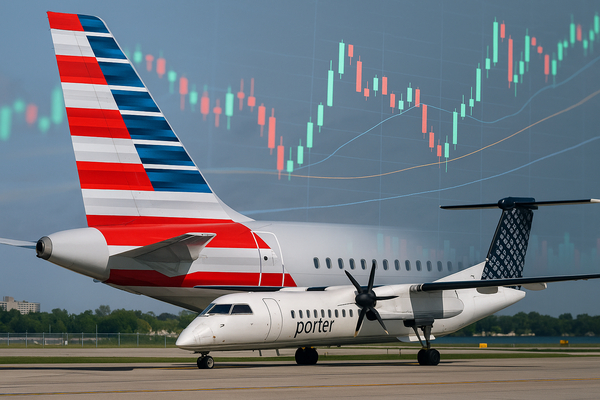
American Airlines (NASDAQ:AAL) expands its codeshare with Porter Airlines, widening direct ticketing between the United States, Canada and onward markets. This matters now because the deal increases short-term booking options and could lift transborder feed into American’s hubs. In the near term, travelers gain route flexibility; over the long term, codeshares can lift unit revenue by improving connectivity without immediate fleet outlays. The change has local impact in North America and implications for leisure flows to Caribbean and Latin American markets. Historically, North American carriers have used codeshares to reclaim regional traffic quickly; this is a continuation of that playbook.
Headlines: deals, earnings calendars and fresh capital reshape the field
American Airlines (NASDAQ:AAL) announced an expanded codeshare with Porter Airlines that gives customers more one‑ticket itineraries between US and Canada and onward connections. The move is designed to strengthen American’s competitive position on North American routes without adding aircraft.
Delta Air Lines (NYSE:DAL) heads into its third‑quarter results with consensus expectations of $1.53 in EPS and $15.94 billion in revenue for the quarter, making the report on Oct. 9 a near‑term liquidity and demand read for the industry.
United Airlines (NASDAQ:UAL) unveiled a new partnership with Instacart that ties MileagePlus benefits to grocery delivery, a loyalty tie‑in likely aimed at enhancing customer engagement beyond flights. Alaska Air Group (NYSE:ALK) showed modest share strength on the day, closing at $49, up about 1.1%.
JetBlue (NASDAQ:JBLU) added routes to Belize from New York, Fort Lauderdale and San Francisco, reflecting continued expansion of leisure connectivity in the Americas. On the aviation‑technology front, Joby Aviation (NYSE:JOBY) priced an underwritten common stock offering at $16.85 a share to raise roughly $514 million of gross proceeds, a sizable capital infusion for eVTOL commercialization plans.
Shorter items—Archer Aviation (NYSE:ACHR) closed at $12.48 on the latest session, down 8.5%—underscore volatility in the electric air taxi cohort as capital and certification paths remain in focus.
Sector pulse: partnerships, loyalty extensions and capital raises drive the rhythm
Codeshares and loyalty partnerships are the most visible operating lever this cycle. American’s expanded tie with Porter reassigns route economics through commercial cooperation rather than fleet investment. This boosts short‑term revenue per available seat mile (RASM) potential without incremental capital expenditure.
Meanwhile, carriers are broadening revenue touchpoints. United’s Instacart link turns a loyalty program into a daily‑use asset for customers, which can raise engagement metrics and ancillary revenue. JetBlue’s route additions to Belize show continued appetite for leisure demand and route diversification.
On the financing side, Joby’s $513.9 million gross offering at $16.85 a share is a reminder that the new‑mobility segment still requires meaningful capital injections for certification, manufacturing ramp and commercial launches. Aviation suppliers and incumbent airlines react differently: legacy carriers can lean on network strategies and loyalty, while eVTOL players need equity markets to fund runway to revenue.
Winners & laggards: who stands to gain or face pressure
Potential near‑term winners include American Airlines (NASDAQ:AAL). The Porter codeshare should quicken transborder bookings and feed into American’s long‑haul and connecting inventory. That raises short‑term network utility without adding aircraft, and may tighten competition on key cross‑border city pairs.
Delta (NYSE:DAL) is a data focal point. Its Oct. 9 earnings will reveal whether cost control and international leisure demand sustain current margins. The EPS and revenue consensus—$1.53 and $15.94 billion—provide a concrete benchmark investors will use to reprice exposure across the group.
United (NASDAQ:UAL) is pursuing loyalty monetization. The Instacart tie adds a non‑flight revenue touchpoint and could modestly lift engagement metrics. Expect metrics around member activation and miles redemption behavior to be watched by analysts.
Alaska Air (NYSE:ALK) registered a small intraday gain and remains sensitive to West Coast and transpacific dynamics; incremental partnerships like STARLUX and other network links will determine its route density and yield mix.
Leisure‑focused JetBlue (NASDAQ:JBLU) benefits from route growth to tourism destinations such as Belize. These incremental routes typically produce higher load factors in shoulder travel seasons and can lift unit revenues when aircraft utilization is steady.
On the technology side, Joby (NYSE:JOBY) strengthened its balance sheet via the $16.85 share offering, improving its ability to fund commercialization. However, eVTOL names remain binary: regulatory milestones and certification dates will be primary valuation drivers. Archer (NYSE:ACHR) falling 8.5% to $12.48 shows the sector’s sensitivity to capital and execution risk.
What smart money is watching next
- Delta’s Q3 report on Oct. 9: consensus EPS of $1.53 and revenue of $15.94 billion will be read as a gauge of transatlantic and domestic leisure strength.
- Joby Aviation’s offering completion and certification path: the $513.9 million gross raise at $16.85 per share increases runway; investors will watch FAA milestones and demonstration flight progress as timing for potential commercial revenue.
- American Airlines–Porter codeshare rollout: monitor when the new itineraries appear in global distribution systems and initial booking patterns. Early load factors will reveal whether the tie creates immediate incremental revenue or simply cannibalizes existing flows.
Closing take‑away
Partnerships and targeted capital moves are the decisive near‑term themes. Legacy carriers are leveraging commercial agreements and loyalty extensions to grow connectivity and ancillary revenue with limited fleet investment. At the same time, aircraft‑technology firms are using public markets to extend cash runway toward certification and commercialization. For investors, the single most important insight is this: network and loyalty maneuvers can lift returns quickly for incumbents, while tech names require execution on certification and effective capital use before that promise reaches the P&L.












